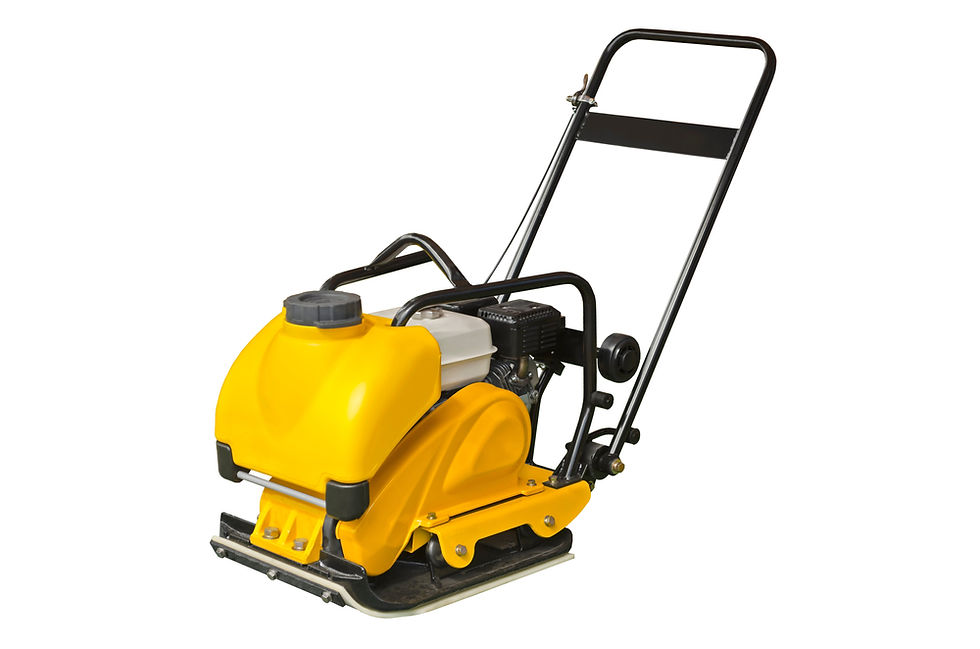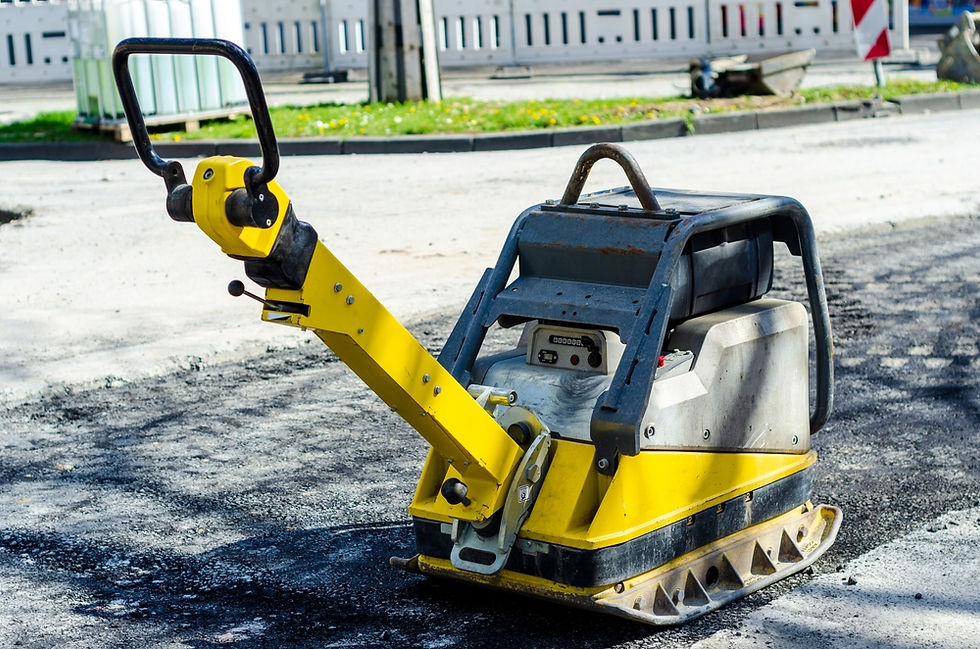Beginner's Guide To Selecting The Perfect Plate Compactor
- Ashley Kinsela
- Aug 6
- 10 min read

Have you ever stood in a tool hire shop, gazing at the rows of compaction machines while wondering which ones actually suit your needs? Or have you maybe been scrolling miles through endless online listings in an attempt to find out what size plate compactor would fit your driveway project? Or even asking yourself, "What on earth is a wacker plate anyway?"
Fear not! Most people feel very much lost in this area when it comes to choosing a plate compactor. The very mention of the phrase "technical specifications and industry language" can send the prospective user reeling. A new patio, a solid base for a garden shed, or that long overdue renovation of a driveway could all trigger the thought that understanding plate compactors is the primary step for achieving what looks professional.
This is the ultimate guide for everything that you would require to select plate compactor as per your project requirement. Types will be discussed followed by how to arrive at the correct size for your requirements. Practical tips for getting the best results while working will be shared. So at the end of it all, you should be entirely confident when choosing equipment to match your design requirements and fit your budget as well.
What Is A Plate Compactor?
The Basics Of What A Wacker Plate Is
A plate compactor is basically just a heavy, flat plate that rapidly vibrates to compact and level loose material. If you think of it as a really powerful, motorised version of tamping soil with your feet - except it's far more efficient and makes a lot more stable base -, the whole thing becomes really simple. The vibration action forces air pockets out of the material and causes it to settle to a dense, solid foundation that will not shift or settle over time.
So people refer to it as a "wacker plate." The name comes from Wacker Neuson, one of these original manufacturers of this machine. In the UK, we tend to use "Hoover" as the general name for all vacuum cleaners, and so this brand name has stuck. Basically, you will find a heavy steel base plate, an engine (petrol or electric), and a handle for guiding the equipment across your work area.
How Plate Compactors Work
We have vibration, we have weight. We start the engine, and that drives around a rapidly spinning eccentric weight, creating powerful vibrations that go through the base plate into the material below and lead to rearrangement of particles into a tighter configuration. It is incredibly similar to "tapping" a jar of sugar to make more fit inside, just with a whole lot more oomph!
That vibration typically runs 3,000 to 6,000 vibrations per minute, depending upon the model. The two-act combination of rapid movement and the sheer weight of the plate itself produces compaction depths that could not be achieved by hand methods. Most plate compactors will compact well down from 30-60 cm in depth, but this does vary according to machine size and type of material being compacted.
The Difference Between Plate Compactors And Other Compactors
Plate compactors are brilliant tools for many jobs but not the only forms of compaction equipment available. Jumping jack compactors (rams) produce quite a concentrated thrust, making them ideal for use in cohesive soils and trenches but less so in granular materials; they literally just jump up and down deep compaction in confined areas where a plate compactor was unable to fit.
Roller compactors are great for huge flat areas, such as car parks or roads. They create a great surface finish without applying enough concentrated force for deeper compaction. Plate compactors are going to do the trick for most DIY and small contractor projects - small enough to be manageable, yet versatile enough for various materials, and offer a great level of compaction on your typical residential projects.
What It Used For? Common Applications
Preparation Of Driveways And Pathways
A stable driveway is established long before any surface treatment is down. Whether you are laying block paving, gravel, or preparing for concrete, it must always provide a well-prepared base. This is where the plate compactor does an excellent job of creating a firm, level foundation to avoid any future settling or failure of the surface above. It compresses the sub-base materials, which are usually MOT Type 1 aggregate, into a firm platform that can support a vehicle's weight without shifting.
You will deposit your sub-base material in layers of no more than about 10-15 cm at a time. Each layer is then compacted using the plate compactor, with distribution of the moves in overlapping passes: once the material ceases to show any settling, you should stop. You may consider that your compaction is adequate once the plate is just slightly "bouncing" and leaving few marks on the surface below. This disciplined method will afford a foundation capable of lasting for decades.
Preparation Of Paving Parameter
Paver installations will concentrate all attention on the base preparation. The beauty of your finished patio or walkway depends entirely on what is underneath. Plate compactors prepare the sub-base below and the sand bedding on top en route to creating a stable foundation for pavers so they remain level and resist movement with time.
The process generally goes: compact gravel sub-base first, then install a layer of sharp sand for bedding of the pavers. Now, application matters- excellent compaction on the sub-base but a soft touch vis-a-vis the sand. Overcompacted sand becomes an impenetrable layer which would not allow the paver tiles to sit correctly; under-compact and they will sink. Most professionals suggest going over the sand surface very lightly one or two times, just to firm up that layer without making it density-concrete like.
Landscaping And Garden Jobs
Plate compactors are indispensable for various works in a garden beyond hardscaping. Building a shed in the garden? You will need compacting there to avoid any settlement. Building raised beds or retaining walls? Compaction behind the wall prevents soil movement and thus structural failure. Even the basics such as laying artificial grass will greatly benefit from the well-compacted base with proper drainage to avoid dips.
Landscape contractors are frequent users of plate compactors when preparing spots for turf laying. Good soil compaction will produce good root-soil contact but will preserve sufficient porosity for grass growth. Compaction is thus a balancing act- too much means restricting root growth, while less would mean undulation in the lawn.
Types Of Plate Compactors; Find Your Best Match

Single-Direction Plate Compactors
Forward plate compactors are the entry-level machine for most users. These simple machines move forward only, using vibration and weight to achieve compaction. The disadvantage of the compact machines is that they are lighter than reversible but less expensive and easy to use. These are fine for the purposes most DIY residents or small professionals have in mind when doing works.
For a forward-only machine, the simplicity makes it very user-friendly. There is no reverse gear to learn; there are no additional controls to fiddle with- simply start, move the machine forward under power, and stop. They are the best for compaction of granular materials across open areas where maneuverability is not of much concern. Most models in this category weigh 50-100kg and apply adequate compaction forces at depths of 30cm.
Reversible Plate Compactors
As soon as you climb aboard a reversible plate compactor, you will be struck by the convenience of its operation. The rotation of the eccentric weight can be reversed via a simple control, allowing the operator to move forward or backward with equal ease. Such design is transformative for productivity in constrained areas and reduces operator fatigue on larger jobs.
Reversible plates generally are more powerful than their unidirectional counterparts. They give higher compaction forces for deeper lifts and harder materials with operating weights between 100-750 kg. The heavier models can achieve effective compaction depths exceeding 60 cm, allowing them to be used in challenging commercial applications.
Electric Vs Petrol Plate Compactors
The power supply question most often comes down to the individual situation. Petrol plate compactors reign supreme in the trade for a reason: They offer total mobility, boast a constant power curve, and suit the majority of outdoor applications. Reliable power with decent fuel consumption is provided by the modern four-stroke engine, whereas two-stroke engines give low weight but sacrifice fuel mixing.
Electric plate compactors, while rare, excel in a few situations. No emissions, quiet, and require little maintenance. Most areas that would use electric models are indoors, or at least in noise-sensitive projects. These chassis fit nicely with rental companies working within urban areas where noise restrictions apply. The drawbacks are limited operating range (cord length) and usually lower power.
What Size Plate Compactor Do I Need?
Understanding Compaction Force And Plate Size
Balancing the force exerted by the compactor divided by its size is worth consideration when one selects the appropriate compactor. The measured force, which is expressed in kN (with 1kN equaling about 225 lb), indicates how hard the machine directs pressure onto the area. The smallest compactor of 10-20kN often could compact granular soil well enough – sufficient for pathways or landscaping – whilst those over 50kN become useful when compounded on to the sub-base. However, force only contributes half of the story.
The width of the plate considers both productivity and maneuverability. Wider plates increase the amount of ground covered in each pass, speeding up the pace of large area compaction. Larger plates, of course, can be found heavier to manipulate in tight and unstable conditions of gravel where smaller plates are required. Commonly the plates range in widths anywhere from 300mm for the compact models to 600mm or more for the heavy-duty machines. The most appropriate for most residential applications would best fall in the range of 400mm to 500mm.
Matching Compactor Size To Your Project
Small projects like garden paths or small patios typically need modest equipment. A plate compactor weighing 50-90kg with 10-15kN force handles these jobs efficiently. The lightweight allows for maneuverability—easier for transport and storage—while still providing good compaction in general.
The 90-150kg weight class does a higher level of compaction work with enough thrust under the plate for most contractors aiming at the larger jobs. These offer faster coverage and indicate fairly warm productivity uplift whilst coping with deeper layers. They thus stand out to be more general in use and will go a long way, including in residential and a lighter commercial project.
Weight Consideration Issues For Different Materials
The compaction weight is inherent in the compaction that will comply with the material, so choose wisely. Granular materials, gravel or sand, generally compact with little effort, while an abundant mass will segregate the material and produce a "crushing effect." For a typical sub-base application, small models are most effective when inherent weight shall comply with the granulation of the particular material; i.e., for MOT Type 1. For clay and cohesive soil, on the other hand, more force is needed to break its inherent cohesion. While jumping jacks are popular for true clay, plate compactors can hold up the task of clay-minerals-modified material if weight and frequency are adjusted accordingly. Normally, heavier plates and a lower frequency tend to work well in such scenarios, which are quite hard to compact.
Key Features To Look For In The Best Compactors

Engine Power And Performance
Engine choice has a direct relation to operating performance and user satisfaction. The acceptable range of horsepower for the homeowner plate compactors usually runs above 3 to 10. Brands like Honda, Briggs & Stratton, and Robin have come to mean quality at the higher price points, with proven reliability and wide ranges of available parts. But more power doesn't always mean better compaction: they perform better when the power matches the size and weight of the plate.
For a heavier machine, models come in with either a traditional recoil or electric starting, most of whom use the pull option. Especially on bulky models, the electric start system simplifies ignition; however, this technology raises weight and controls complexity due to system preference. A properly managed single pull-start on a maintenance basis means that the operator can do the work earned and still feel pleasure.
Vibration Frequency And Centrifugal Force
Vibration frequency is set with adjacent determination of compaction performance and centrifugal force. High frequencies are best suited to granular materials, whereas lower frequencies, with higher amplitudes, work wonders for soils that feature a silty component. Manufacturers who know their products well also offer more ease in direct dosage via various settings of their machines.
Centrifugal force (caused by the eccentric weight turned by rotation) accounts for the energy for compaction. Increasing force is not always good in that high force can become detrimental to the loosening of the materials and scaring finished surfaces. Force is best manipulated by the good manufacturers in terms of the plate loadings and conditions. Knowing these specifications will help match machinery to materials.
Manoeuvrability And Handle Design
Ergonomics cannot be understated when it comes to the design of the machine. Users and environments are not really forgiving when the machine is too heavy, not comfortable, and never ever designed for proper balance. Get yourself a machine with adjustable handles for comfort, ensuring it supports various heights, reduces the transfer of vibrations, and allows for ease of comfort for the operator. The use of applied anti-vibration regulation tends to perfection when it comes to alleviating operator fatigue-most critical when labeling professional operators which, depending on the circumstances, may have to stand facing daily use. A few units have foldable operation handles for ease during transportation and storage, a favorable boost for contractors not able to spend much money on fancy vans.
Positions of controls go a long way in determining the safety and convenience. Throttles of such machine control must come to rest comfortably at the users' hands-without extending or straining, while emergency stops remain readily available. Units that can be reversed ought to possess straightforward forward/reverse controls, which would make operation a bit harder borrowed. The best designs of compactors offer a one-handed release, thus making it possible for one hand to grab a handle or fiddle with a rope.
Final Thoughts: Choosing Your Perfect Plate Compactor
Having seen your fair share of different options on plate compactors, you are now prepared with the necessary knowledge to step into your purchase. Whether you're going to take on projects on weekends or go into business, learning about this machinery would be an advantage to your successful journey. Do not forget to assess organic needs, budget, and what you plan in the future around handheld vibrating compact plate models.
Now for homeowners, the best choice lays in those units ranging from 60-90kg forward plate compactors. These units bring the perfect balance between capability and manageability. These machines are suitable for tackling most DIY projects but remain affordable enough to have around with minimized storage needs. So, if you only need it for one or two projects, renting is the way to go. Why would you want one that will eat up your capital and the storage space should you instead rent it?
.png)






Brisbane Towing And Recovery offer affordable towing in Brisbane for cars, containers, and equipment — available 24/7! Whether it’s an emergency or scheduled pickup, count on us for cheap tow truck Brisbane services that are fast and reliable.Emergency recovery, Fast response,Budget-friendly rates.Call now for help or visit: https://brisbanetowingandrecovery.com.au/ .Your go-to for cheap tow truck in Brisbane, Australia!